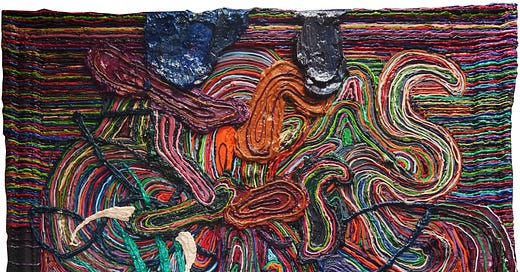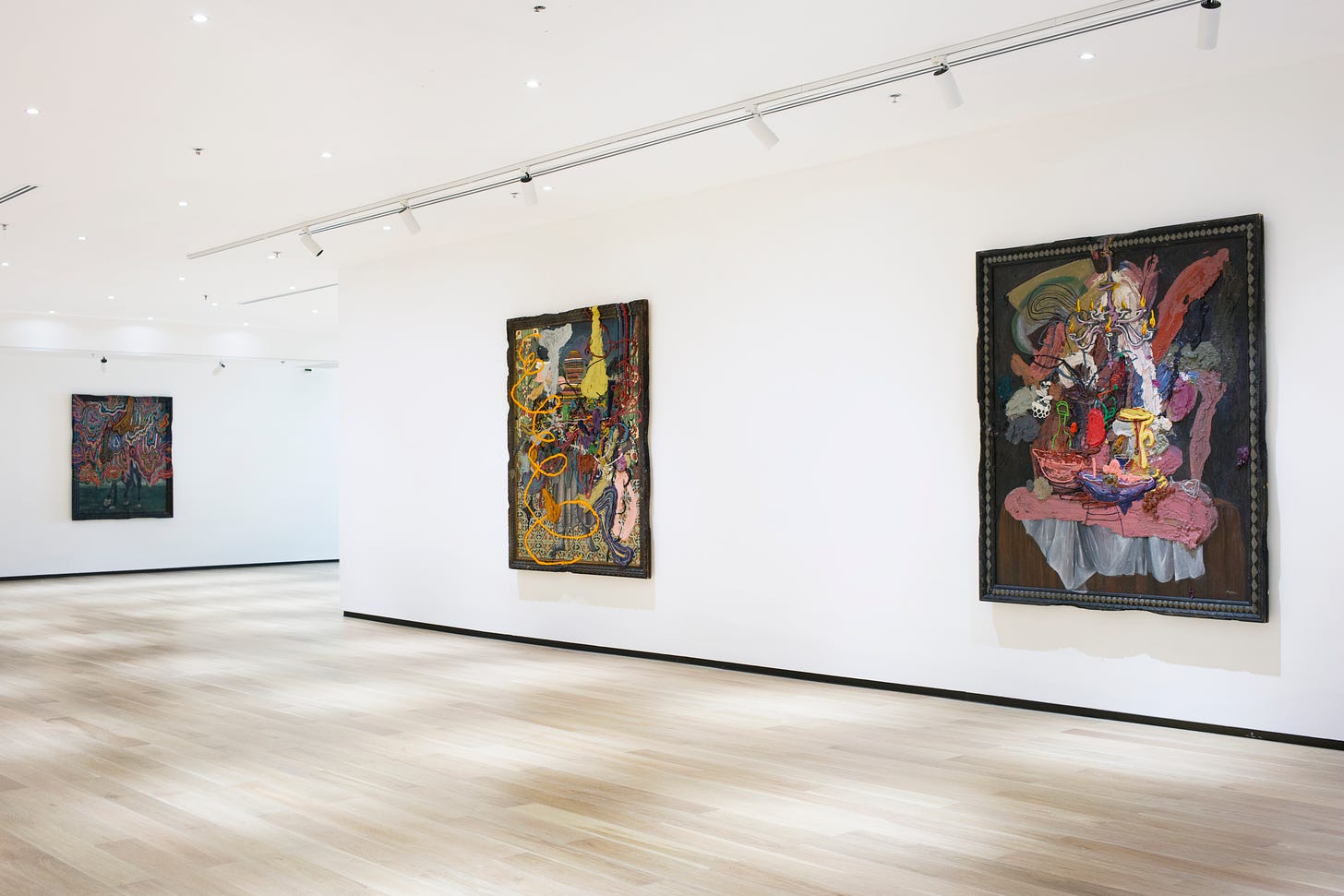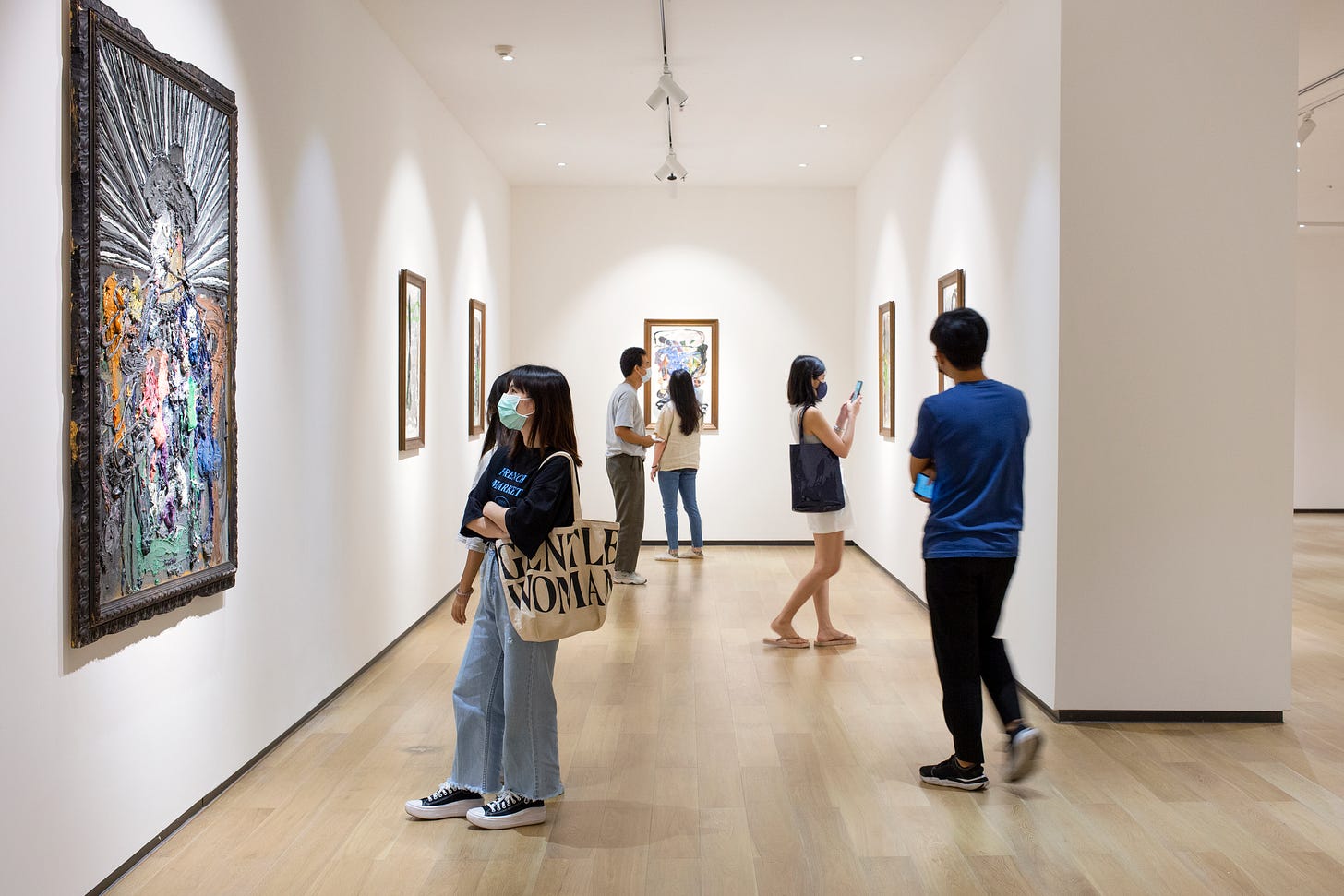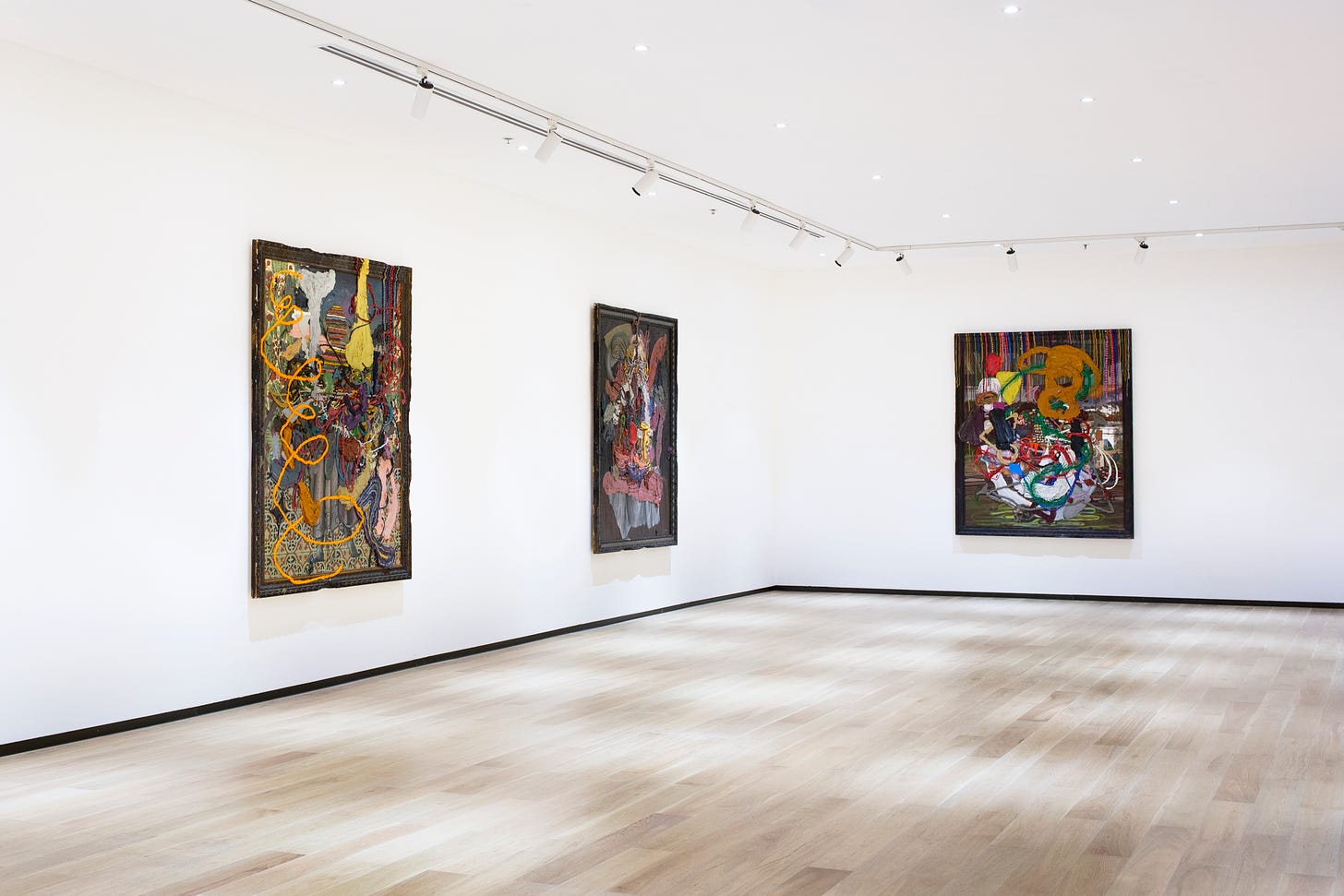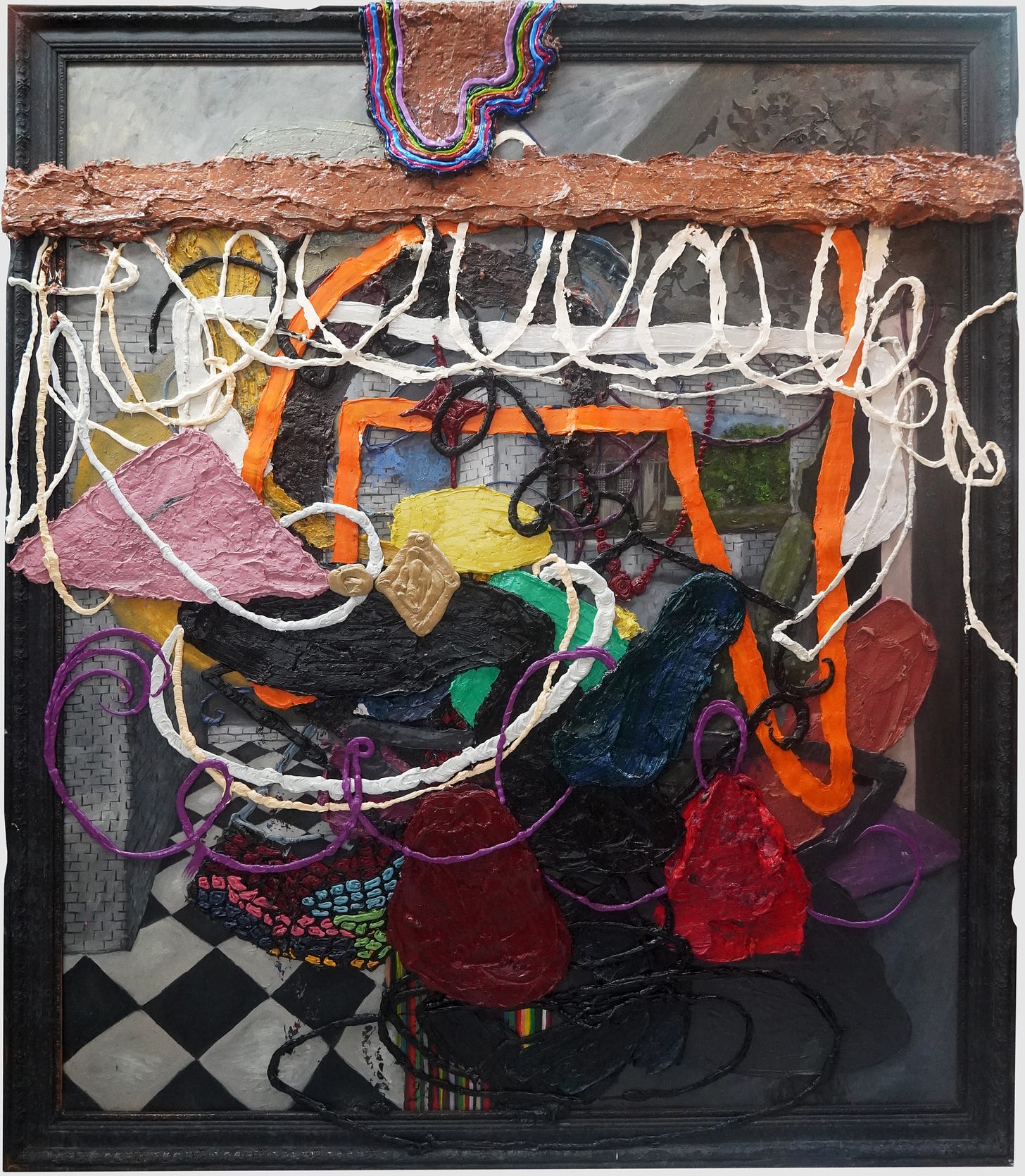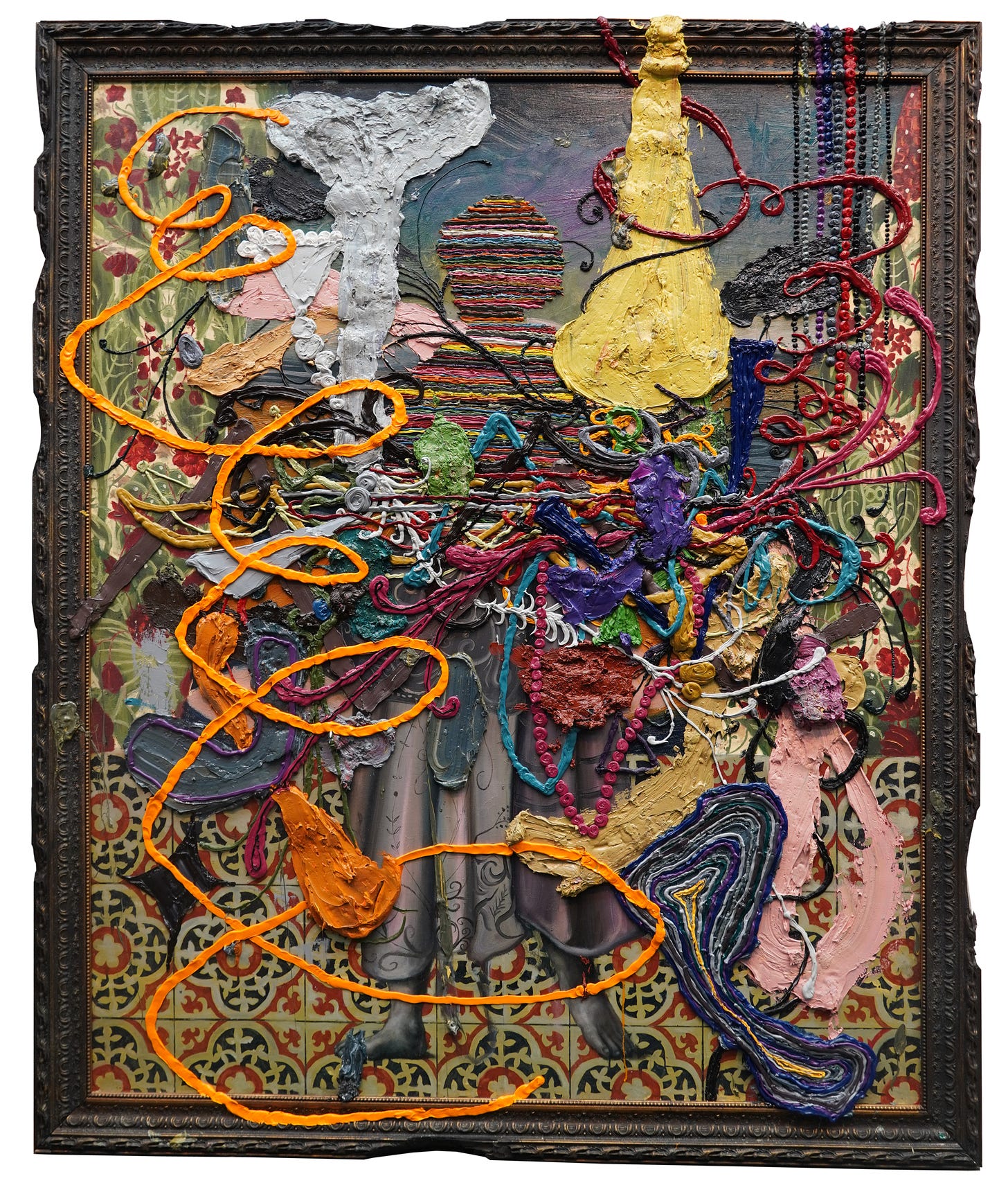Magazine 43 proudly presents Tang Contemporary Art, Bangkok and Filipino artist, Jigger Cruz on his most recent exhibition, “Paradigmal Traps” curated by Michela Sena. The exhibition has featured both paintings and drawings by the artist, created in 2021.
Jigger Cruz returns with a body of work that challenges perception rendered in his signature style. Tubes of oil paint squeezed onto the canvas, spray painting and decisive, confident strokes create a rough and thick three-dimensional surface that meets in a grid of colored lines, in a nervous tangle. Strips of color overlap, travelling in parallel or intertwining, pushed by the artist’s impulsive gesture.
While seemingly a struggle of colors and lines, the result of a passionate and energetic action, is generative of a new image, at the same time destroying the image which lays underneath. In fact, the dense, compacted, and impastoed surface, partially or totally, hides the figurative background which are normally, in Cruz’ works, representations of subjects from Flemish or Renaissance art repertoires. Albeit frayed and mutilated, in some works, the original image survives his interventions, but at other times however, the realistic representation is completely distorted and destroyed, making it difficult to identify the initial subject.
Swept away by the artist’s destructive force, the underneath image undergoes a sort of primitive expression of violent psychic energy, so overwhelming that the principle of death and life happen simultaneously. Like an equally primitive "fear of emptiness", his energy fills the whole canvas. The painting explodes, overflows from the frame’s margins, covered with color, sometimes burned and corroded.
Radically different from the “painter”, who is placed in front of the easel and delicately transfers minimal quantities of color, Cruz relies on action as the essence of the creative process, like in a shamanic ritual; his proactive intervention on the canvas represents a complete, involving and all-encompassing artistic practice.
Deliberately playing with the ideas of disfigurement and vandalization through his thick oil layers and color tangles, Cruz reviles and destroys those familiar images painted on the background, making the destruction an integral part of his art aesthetic understanding. Cruz’ assemblages of recognizable objects and dark forms, intertwining into each other, lead to a reflection on the very matter of painting. Encrypting linearity, his tangled colored vortexes decipher the paths of a new mapping, unhinging the universally accepted culture’s fixed points. Thrown into a dizzying displacement, oriented by new cardinal points, the observer loses any known landmarks, and finally embraces new alternative ways of perception.
Such a dense, energetic process gets many layers to its conception. And while Cruz’ decisive actions are the translation into art of his dissent versus the common sense and an obvious way of reading reality: his intense energy also arises from the reaction to a specific cultural environment. Like many Filipino artists of his generation, Jigger Cruz carries the burden of a cultural complex deriving from domination and colonization. His concerns extend to the social conditions of his homeland particularly on Catholicism, the dominant religion in the Philippines.
His gesture can be seen as a reaction to the dogmatic vision imposed by the colonizers centuries ago, and that molded and was the premise for many of the conflicts and contradictions of Filipino contemporary society. Cruz cancels with his gestural painting and "colonizes" the icons of Baroque culture. Obscuring and canceling the whole painting space, he erases the symbols of a culture, which perpetuated its universal supremacy.
The obsession of his signs extends far beyond the frame, slipping into a fractal collapse and to infinity. Endlessly reiterating its power, Cruz’ refusal extends towards any pre-imposed culture and becomes a protest against any blind truths - the rejection of colonial culture’s imposition corresponds to the rejection of any bourgeois culture's dogma.
At the same time, if destroying the Western traditional subjects is Cruz’ way to comment on the weight of history, from another point of view, it represents his struggle of detaching himself from Western art, which with its historical narrative is inevitable in his practice. Significantly, Cruz does not completely erase the original images.
Still his gesture and his act of rebellion function as a statement that breaks the rules of traditional art. Cruz’s operation is the premise of a cathartic renewal, passing through subtraction and abstraction, becomes an action of self-affirmation. The result is the genesis of a germinating chaos leading to unveiling a new reality. In being cathartic, his pictorial denial has become almost a religious ritual for the artist.
This exhibition, continuing Cruz's latest developments, features a color palette subtly desaturated, almost tending to cool tones, which smoothly depart from the artist’s typical use of bold, vivid colors. From the original aim of producing contrasts and shock, Cruz’ palette guides us into a more discreet and minimalist atmosphere, perhaps turning from an explicit dialectic with the external world towards an introspective dimension. Smoothly flowing onto a reflection on his own aesthetic, a more self-referential phase, he makes blunt the original vehemence, allowing his art the state of a statement, still questioning itself to find its own relevance.
Born 1984, Malabon City, Manila, Philippines, Jigger Cruz graduated with a Bachelor of Fine Arts at the Far Eastern University, Manila and also trained at the De La Salle College of Saint Benilde before pursuing a full-time career as a painter. The artist has been listed in international auction houses around the world, and has exhibited in both solo and group shows locally and internationally, from the Philippines to Thailand, Indonesia, Singapore, Japan, Germany, Switzerland, France, Italy, Austria, and the United States. His work can be found in multiple public collections, including: The Dikeou Collection, Denver, CO, USA; Guggenheim Museum, NY, USA; Saatchi Collection, London, UK; and Zabludowicz Collection, London, UK.
Cruz’s art practice is characterized by his idea to play with defacement and vandalization, making use of oil colour, spray paint and rough interventions directly on the canvases, which is sometimes burned and, in some cases, even to cut. Each artwork is created by the artist from a canvas previously painted, where he copied the Flemish and Post-Renaissance masters. Apparently without a logical scheme, Cruz applies layer by layer the dense oil colour, not only hiding, rather mystifying the classical backdrop. In this way the artist explores, through his artworks, the deep relationship between the canvas and its meaning, past and present, figuration and abstraction. The figures of the classical paintings that transpire below, remind the viewer of the painstaking pictorial activity and the artistic historical baggage of the contemporary painter.
For more information about the artist and the gallery, please view or contact:
Tang Contemporary Art, Bangkok
Room. 201 - 206
River City Bangkok
23 Soi Charoenkrung 24,
Talad noi, Sampantawong,Bangkok,10100, Thailand
Email: kk@tanggallery.vip
Tel: +662 000 1541
Opening Hours:
Tuesday to Saturday
11 am - 7 pm (Closed on Public Holidays)
***images and infromation courtesy of Tang Contemporary Art, Bangkok***

